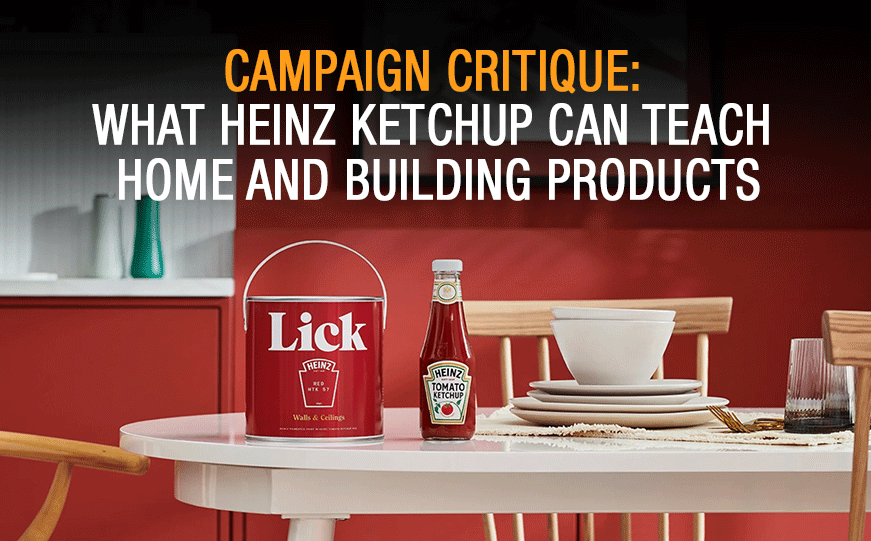In the past two weeks, the design-oriented popular press has exploded with buzz regarding the activities of a boutique paint brand. And the world’s largest purveyors of ketchup. In case you missed it, Lick, a UK-based paint and wallcoverings brand, released a limited-edition color they call HTK 57… the color of Heinz ketchup. Kraft-Heinz, Inc is an enormous company by any measure. With $26 billion in annual sales this co-branded paint campaign is a drop in their overall marketing budget.
Lick, on the other hand, is a four year-old startup founded by two entrepreneurs… and backed by venture capital.
In the world of branding, creativity and innovation are considered “currency”.
With viral, news-worthy curiosities… the dream of many marketers. And that’s as true for home and building products as it is for any other category.
Brands are constantly seeking new ways to capture the attention of their target audiences. To help make products stand out in a crowded market. However, sometimes a creative idea can go too far… leading to an identity being diluted.
Or even damaged.
Lick Paint’s recent limited release of Heinz ketchup-colored paint is a prime example of such a dare-we-say, “messy” gamble.
While the idea of associating a popular condiment with a paint color may seem whimsical — even eye-catching at first glance — a deeper examination from a branding perspective reveals several flaws in this building materials marketing strategy.
Confused Identity
One of the fundamental principles of branding is maintaining a clear and consistent identity. Lick Paint is known for its high-quality — some might even say, expensive — environmentally friendly paint products. And a “minimalist design” aesthetic. Introducing a ketchup-colored paint, even as a limited release, muddles the brand’s identity. Those who have been drawn to Lick Paint’s clean and sophisticated image may find it difficult to reconcile this new product’s positioning pivot… with their established perception of the brand.
Risk of Negative Associations
Ketchup, after all, is often associated with messiness. Even a lack of sophistication. Not qualities typically one would seek in an “aspirational” paint product. By aligning with a condiment known for its potential to create untidy situations, Lick Paint subconsciously risks associating their brand with drips, drabs and limited consideration… all potentially counterproductive to its existing brand equity.
Limited Market Potential
While novelty items can generate initial buzz, long-term market potential should be cumulative in effort. Heinz ketchup-colored paint is unlikely to create a sustained demand for living spaces — alienating some with a short-term gimmick — instead of building upon a viable product offering. Lick is only offering 570 cans of HTK 57 so clearly, the longevity of this color isn’t a consideration. How soon will the buzz will wear off — we’re left wondering if either brand will gain enough from this exposure — to have made it all worthwhile?
Perceived Quality Dilution
The perception of product quality is paramount in the paint industry. Lick Paint’s reputation for delivering high-quality, environmentally friendly paints may be undermined by introducing a product that appears more as a marketing stunt… than a serious offering. Will the design community and its influencers begin to question the integrity of the brand? And potentially harm Lick Paint’s credibility?
Alas, it’s too late for a follow-up branding experience during Burning Man’s rain last week… to promote the paint’s ease-of-cleanup.
Brand Erosion
Brands must build trust over time. Through consistent messaging and product delivery.
There are ample opportunities in challenger marketing, that Lick Paint could be deploying — for novelty paint themes — that won’t threaten to erode the equity of “trust”.
Which will contribute to help make the brand appear consistent. And serious about its core business. Aimed squarely at… growing customer loyalty for all of the right reasons.
Lick Paint’s limited release of Heinz ketchup-colored paint — while a bold and attention-grabbing move — raises significant concerns from a branding perspective. Why risk the potential confusion and negative associations? Or alienating core audiences with far-reaching consequences for the brand’s long-term challenger promise?
While innovation is essential in branding, it always should be aligned with a brand’s core values. And its identity… to ensure consistency and trustworthiness.
Interested in exploring creative ways to growing your brand’s target audiences as a challenger brand? Send an email to sk@kleberandassociates.com to get the conversation started. Or download the following white paper to consider some proven methods.





